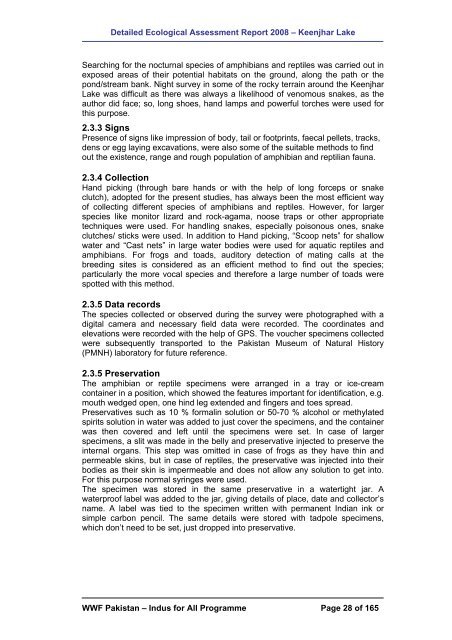Untitled - WWF - Pakistan
Untitled - WWF - Pakistan
Untitled - WWF - Pakistan
Create successful ePaper yourself
Turn your PDF publications into a flip-book with our unique Google optimized e-Paper software.
Detailed Ecological Assessment Report 2008 – Keenjhar Lake<br />
Searching for the nocturnal species of amphibians and reptiles was carried out in<br />
exposed areas of their potential habitats on the ground, along the path or the<br />
pond/stream bank. Night survey in some of the rocky terrain around the Keenjhar<br />
Lake was difficult as there was always a likelihood of venomous snakes, as the<br />
author did face; so, long shoes, hand lamps and powerful torches were used for<br />
this purpose.<br />
2.3.3 Signs<br />
Presence of signs like impression of body, tail or footprints, faecal pellets, tracks,<br />
dens or egg laying excavations, were also some of the suitable methods to find<br />
out the existence, range and rough population of amphibian and reptilian fauna.<br />
2.3.4 Collection<br />
Hand picking (through bare hands or with the help of long forceps or snake<br />
clutch), adopted for the present studies, has always been the most efficient way<br />
of collecting different species of amphibians and reptiles. However, for larger<br />
species like monitor lizard and rock-agama, noose traps or other appropriate<br />
techniques were used. For handling snakes, especially poisonous ones, snake<br />
clutches/ sticks were used. In addition to Hand picking, “Scoop nets” for shallow<br />
water and “Cast nets” in large water bodies were used for aquatic reptiles and<br />
amphibians. For frogs and toads, auditory detection of mating calls at the<br />
breeding sites is considered as an efficient method to find out the species;<br />
particularly the more vocal species and therefore a large number of toads were<br />
spotted with this method.<br />
2.3.5 Data records<br />
The species collected or observed during the survey were photographed with a<br />
digital camera and necessary field data were recorded. The coordinates and<br />
elevations were recorded with the help of GPS. The voucher specimens collected<br />
were subsequently transported to the <strong>Pakistan</strong> Museum of Natural History<br />
(PMNH) laboratory for future reference.<br />
2.3.5 Preservation<br />
The amphibian or reptile specimens were arranged in a tray or ice-cream<br />
container in a position, which showed the features important for identification, e.g.<br />
mouth wedged open, one hind leg extended and fingers and toes spread.<br />
Preservatives such as 10 % formalin solution or 50-70 % alcohol or methylated<br />
spirits solution in water was added to just cover the specimens, and the container<br />
was then covered and left until the specimens were set. In case of larger<br />
specimens, a slit was made in the belly and preservative injected to preserve the<br />
internal organs. This step was omitted in case of frogs as they have thin and<br />
permeable skins, but in case of reptiles, the preservative was injected into their<br />
bodies as their skin is impermeable and does not allow any solution to get into.<br />
For this purpose normal syringes were used.<br />
The specimen was stored in the same preservative in a watertight jar. A<br />
waterproof label was added to the jar, giving details of place, date and collector’s<br />
name. A label was tied to the specimen written with permanent Indian ink or<br />
simple carbon pencil. The same details were stored with tadpole specimens,<br />
which don’t need to be set, just dropped into preservative.<br />
<strong>WWF</strong> <strong>Pakistan</strong> – Indus for All Programme Page 28 of 165
















